With an over 200,000-square-foot campus and more than 70 surface finishing processes, Techmetals in Dayton, Ohio, rarely had to tell a customer it couldn’t provide a coating for its parts.
But when Techmetals President Phillip Brockman began to worry that some of his hexavalent chromium customers wanted to move to an alternative process, he quickly gave them no worry to fret.
Techmetals has added high-velocity oxy-fuel (HVOF), air plasma treatments, and twin-wire arc spray coatings to its arsenal of processes using robotics, making it one of North America's most complete finishing processors that support numerous industry and customer specifications, including AMS 2447, AMS 2448, MIL-STD-1687, and AMS 2437.
“We were always going to put something in for vertical integration for our customers,” Brockman says. “We started looking at HVOF and other thermal spray processes as a conversion for some customers that want to leave chrome. We didn’t want to lose them all together.”
He says Techmetals customers have requested over the years that they add thermal spray processes because they have become a known and trusted supplier and have partnered with customers with additional processes in the past.
‘HVOF Beats Chrome’ in Some Applications
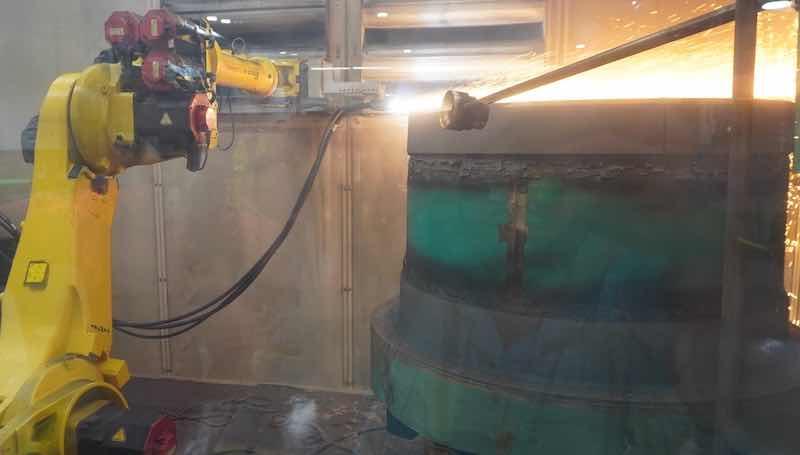 Techmetals has added high-velocity oxy-fuel (HVOF), air plasma treatments, and twin-wire arc spray coatings to its arsenal of processes using robotics.And when Brockman and his team began investigating what thermal sprays to add, he came away with a new reverence for the processes.
Techmetals has added high-velocity oxy-fuel (HVOF), air plasma treatments, and twin-wire arc spray coatings to its arsenal of processes using robotics.And when Brockman and his team began investigating what thermal sprays to add, he came away with a new reverence for the processes.
“Chrome is still superior in some applications, but many applications using HVOF beat chrome,” he says. “It's not a fix-all, but now we're a one-stop shop for customers trying to get out of hard chrome, and we have the best alternative for that, which would be HVOF.”
HVOF is a thermal spray coating application that improves or restores a part’s surface properties or geometry. It has been around since the 1980s and works by mixing fluid fuel and oxygen fed into a combustion chamber and ignited. This results in gas with an extremely high temperature and pressure being ejected through a nozzle at supersonic speeds.
Thermal spray coatings are often used to help prevent devastating issues such as wear, erosion, abrasion, and corrosion of integral parts that demand flawless function and reliability. This specialized spray offers unique versatility and benefits in repair and restoration capacities and with new parts used in the aviation, oil/gas, and power generation markets.
“We want to be their overflow and provide proof grinding, or we'll do the pre- and post-grinding and get it to them if they want a final dimension. Our goal is to get customers quick turn time, and we want to be able to control the turn time versus having to send it out and get it back to them.”
The HVOF coating also typically protects corrosion by incorporating nickel and chrome into the matrix with tungsten carbide and chrome caribe blends. Hundreds of thermal spray materials are available, allowing various options to create the perfect high-velocity surface for the part.
Plasma Thermal Spray and Twin Arc Extremely Versatile
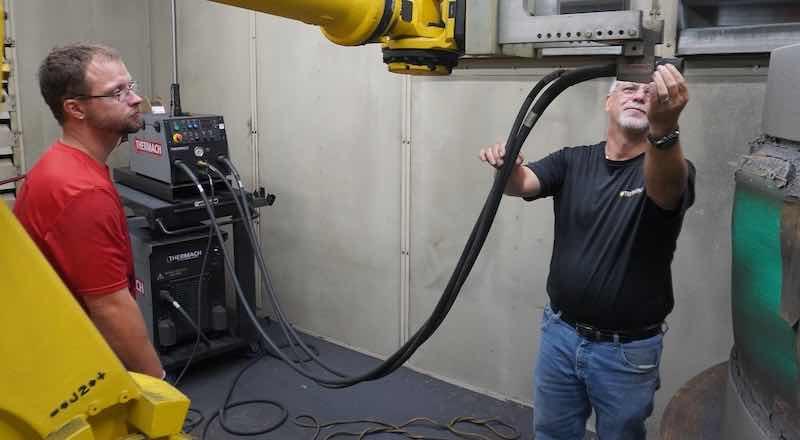 Brockman hired industry expert Mark Simpson, right, as the Operations Manager of Special Processes for Techmetals to help install and operate the thermal spray operations smoothly.Plasma thermal spray solutions have a high temperature, making this option extremely versatile. They are compatible with all sprayable ceramics and virtually all metal and ceramic materials, offering amazing wear properties.
Brockman hired industry expert Mark Simpson, right, as the Operations Manager of Special Processes for Techmetals to help install and operate the thermal spray operations smoothly.Plasma thermal spray solutions have a high temperature, making this option extremely versatile. They are compatible with all sprayable ceramics and virtually all metal and ceramic materials, offering amazing wear properties.
Typical applications include tungsten or chrome carbides, but other materials are also available, such as aluminum oxide, zirconium oxide, titanium dioxide, chromium oxide, and molybdenum-based materials.
Twin-wire arc spray (TWAS) is an economical spray process offering an excellent barrier layer for protecting components from deterioration and enhancing lifespan. By depositing a high-performance thermal coating, TWAS can be a perfect solution for part restoration. Its common materials include nickel/aluminum, nickel/aluminum/moly, stainless steel/moly, Ni/chrome/aluminum/yttrium, and aluminum.
Brockman says Techmetals has been working to educate its customers on its new thermal spray capabilities and aiding through the “transition” of whether thermal spray is right for the customer’s parts.
“We can help our customers through the transition, but we’ve helped transfer a couple of companies back to hard chrome because the HVOF or the plasma just didn't work in that application,” he says. "Chrome is still more economical.”
Techmetals has also added more grinding capabilities. They have always had a five-axis machine available for its chrome work but have added a jib grinder and ID and OD grinders to work on the inside and outside parts to meet specific thickness specifications.
“The thermal spray process originated in the 1900s, and the aerospace industry is one of its biggest technology drivers, but it has been pushed out to other industries like oil and gas. We always say it's in virtually every industry, but very few people know anything about it.”
“It is mainly to be an extension of our customers,” Brockman says. “We don't want to compete with the job shops, and we don't want to go out there and openly get grinding work. We want to be their overflow and provide proof grinding, or we'll do the pre- and post-grinding and get it to them if they want a final dimension. Our goal is to get customers quick turn time, and we want to be able to control the turn time versus having to send it out and get it back to them. It also reduces freight cost and additional handling of parts.”
Adding Industry Expert to the Techmetals Team
 Brockman inspects a new machine that gives Techmetals added grinding capabilities, including a five-axis machine available for its chrome work.Brockman hired industry expert Mark Simpson as the Operations Manager of Special Processes for Techmetals to help install and operate the thermal spray operations smoothly.
Brockman inspects a new machine that gives Techmetals added grinding capabilities, including a five-axis machine available for its chrome work.Brockman hired industry expert Mark Simpson as the Operations Manager of Special Processes for Techmetals to help install and operate the thermal spray operations smoothly.
Simpson has been in the industry for more than 25 years for companies that specialize in developing and applying high-performance thermal spray solutions for the aerospace, military, power generation, automotive, and petrochemical industries.
“The three different processes give us the ability to spray virtually any type of metal or ceramic,” Simpson says. “The thermal spray process originated in the 1900s, and the aerospace industry is one of its biggest technology drivers, but it has been pushed out to other industries like oil and gas. We always say it's in virtually every industry, but very few people know anything about it.”
Brockman says adding the thermal sprays has been Techmetal's long-term strategic goal for about five years, but he wanted to get the right person to lead the department.
“Mark came to us, so we decided that we would put it in quicker than we were putting another line ahead of it,” Brockman says. “We decided to do this first — you can say Mark coming on board catapulted it — and our goal is to get up and running within 12 months, and I think it took us about 12 months.”
New Silver and Nickel Plating Tanks
Large processes have been added to Techmetals’ building, which has a 20-ton crane capacity and 67-foot ceilings. The building configuration allows trucks to drive in through 20-feet by 20-feet doors, and the drive-in bay allows Techmetals to remove parts from a semi with the dual 20-ton hoist system if needed.
Techmetals added a new, larger silver plating line capacity, roughly 12 ft by 12 ft. The company could expand the line even larger—by close to double if needed—to help customers in the defense, power generation, missile programs, torpedoes, electric vehicles, antennas, radomes, and space-type industries.
Large parts for applications such as missiles, bearings, torpedoes, landing gear, or drones may traditionally be coated with IVD, tin-zinc, copper, nickel, lead alloys, bronze, or cadmium plating could be replaced with silver plating; however, one of the barriers to this is the lack of large capacity for large silver plating, which is mostly based on the up-front cost to install a line this size.
Silver has good lubricity, conductivity, corrosion resistance, IR reflectivity, and anti-galling properties. With the right post-processing to prepare the parts for painting and adhesion, it can work well for parts requiring painting.
“This larger process tank adds capacity to run industry specifications such as AMS 2410 and customer OEM specs like BAC5715,” he says. “Our small silver lines can run additional industry specifications such as AMS 2410, AMS 2411, AMS 2412, and QQ-S-365, as well as other customer or BAC5714 OEM specifications.”
Brockman says some applications driving the larger need for silver plating are replacing coatings such as cadmium, lead, gold, tin, or nickel plating.
“A lot of times, we have to do the NDT after we strip a part. We have that capability in-house, too, for mag particles. And being a chemical processing house, we can strip HVOF coatings and add more capability for that as well.”
Techmetal’s new large nickel plating line capacity is 20 ft roughly. Its customers are using it in green energy, power generation, medical, space, defense, FAA repair, and aerospace, which have supported this expansion.
“Some applications in medical and research are Cyclotrons that create medical radioisotopes,” Brockman says. “In some applications, we combine silver and nickel alloys to supply properties driven by customer needs.”
Validating Equipment and Processes
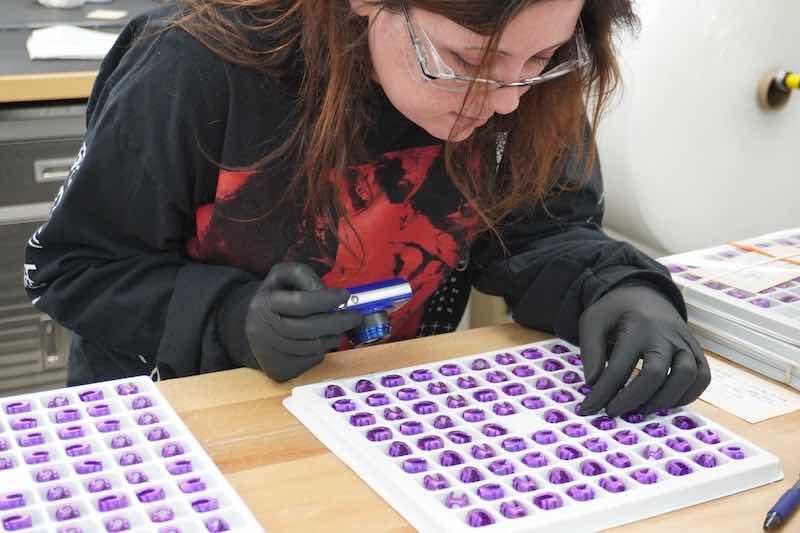 Techmetals has spent the last few months validating the equipment and processes, programming the robots, meeting all the safety requirements, and finally training its employees on the new technology.
Techmetals has spent the last few months validating the equipment and processes, programming the robots, meeting all the safety requirements, and finally training its employees on the new technology.
“The gun is similar to holding onto a small jet engine,” Brockman says. “It's just really loud, so we have a booth where it all goes in, and Mark has set it up with all the robotics.”
The company also offers nondestructive testing, which combines several noninvasive methods for testing parts and materials. Typically, this process identifies and measures imperfections in parts before they are used in public.
Techmetals also holds certification in magnetic particle testing, allowing its customers to verify their equipment or parts with techniques that do not damage them. This form of inspection is one of the most efficient and affordable methods. They are Nadcap for Chemical Processing, NDT, and Coatings, and are ISO 13485 to support Medical Coatings and Medical Validated processes for medical OEM’s and contract manufacturers in the medical implant and orthopedic device industries.
“A lot of times, we have to do the NDT after we strip a part,” Brockman says. “We have that capability in-house, too, for mag particles. And being a chemical processing house, we can strip HVOF coatings and add more capability for that as well.”
While many of the uses of thermal spray are for repair—and for customers to save on fixing rather than replacing components—Simpson says a lot of work is coming online to coat original equipment.
“There's definitely a lot of part repair work, but there is also a lot of OEM work,” he says.
Converting 20,000 Square Feet and Expanding Grinding
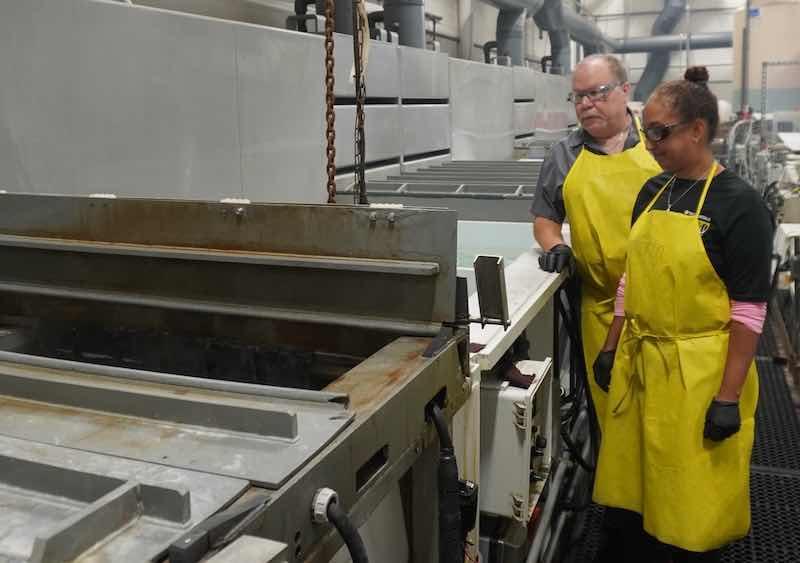 Techmetals has over 200,000-square-foot campus and more than 70 surface finishing processes at its Dayton, Ohio, campus.Techmetals converted a 20,000-square-foot warehouse to house the thermal spray equipment and processes and rearranged some areas to expand the grinding department.
Techmetals has over 200,000-square-foot campus and more than 70 surface finishing processes at its Dayton, Ohio, campus.Techmetals converted a 20,000-square-foot warehouse to house the thermal spray equipment and processes and rearranged some areas to expand the grinding department.
“We moved all of our grinding work centers out of our main plant and into another facility with its own dock doors and air conditioning room control,” Brockman says. “We've added dry film lube with 14 feet capacities, and then we added the thermal spray in that area as well, so it's about 20,000 square feet total.”
Brockman says adding the grinding capabilities will help foster a better relationship with Techmetal’s customers since there seemed to be friction when it came to the customer grinding down coatings to specifications.
“You want to do the grinding because you often get a lot of fights after you send something back to a customer,” he says. “They tell me I put the chrome on wrong, or they often just don't know how to grind it. They can heat check it and crack it, and it’s the same thing with HVOF.”
Customers can also tear the finish if they don’t know how to grind the work properly, or Brockman says they can hit it too fast and cause more problems with the coating Techmetals just applied.
“A lot of people have so much trouble with it in the industry, and they've lost so much talent and grinding capabilities over the years,” he says. “Even large OEMs in the aerospace industry are going away from hard diamond wheels—or hard wheels—and they're going to belt grinding, which is now a method used if struggling using hard wheels. They're using the belt because it's much more forgiving. However, it can have other challenges.”
“It’s about getting them quicker turn times and better quality.”
Simpson says most coatings—chrome, HVOF, or plasma—are generally applied oversized and ground down to a specific tolerance surface finish.
“That is where the grinding comes in during post-finishing the coatings or platings,” he says.
Brockman aims to bring all these processes in-house—and add grinding and NDT—to offer nearly every finishing process and cause fewer issues with customers who need special applications.
Not Finished with Expanding, Adding Processes
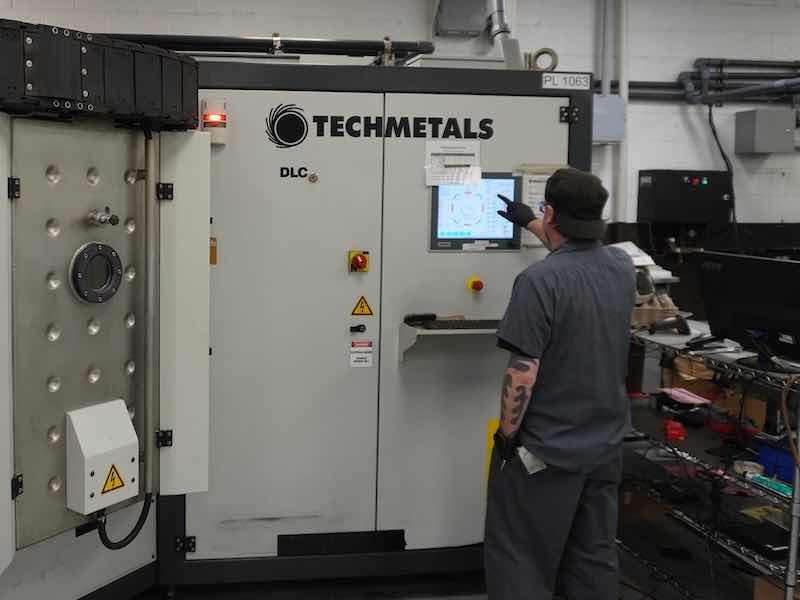 Techmetals also has several PVD machines available for customer work.He is also not finished expanding Techmetals offerings and finishes to meet customer demands.
Techmetals also has several PVD machines available for customer work.He is also not finished expanding Techmetals offerings and finishes to meet customer demands.
“I have two more things that I need to do to finish the circle,” Brockman says. We've also added two large walk-in blasting booths and our smaller ones. We always had ones that were six-foot or four-foot manual booths that you put your arms through. But now we have 12-foot walk-ins that should do a much better job for us.”
Brockman says the goal is for Techmetals to become more of an extension of its main customers by performing more in-house work for them.
“It’s about getting them quicker turn times and better quality,” he says. “We want a good mix, but we want to be an extension of our main customers and work together where we both have some skin in the game.”
Visit www.techmetals.com.



































